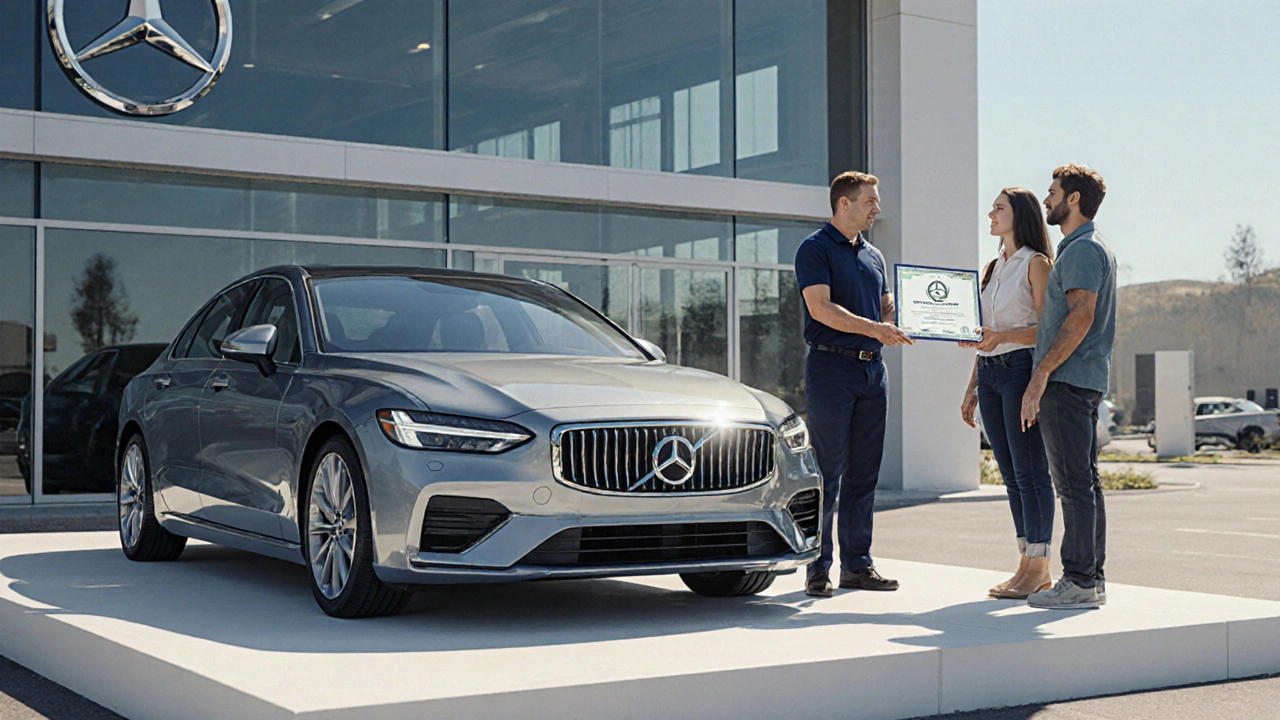CPO Cost Calculator
Calculate Your CPO Total Cost
Estimate monthly payments and total cost including warranty for certified pre-owned vehicles
Total Cost Breakdown
Did you know? CPO vehicles typically cost 10-15% more than comparable used cars. This calculator includes the warranty cost that makes CPO vehicles a better value long-term.
Thinking about getting a certified pre‑owned car but not sure where to start? You’re not alone. Buying a certified pre‑owned (CPO) vehicle blends the peace of mind of a new car with the budget‑friendliness of a used one. This guide walks you through every step, from spotting a legit CPO to sealing the deal, so you leave the lot confident you got a solid ride.
What Makes a Car a Certified Pre‑Owned Vehicle
At its core, a Certified Pre‑Owned Car is a used vehicle that meets strict criteria set by the original manufacturer. The Manufacturer Certified Program typically requires:
- Age under five years and mileage under 60,000 miles.
- A comprehensive multi‑point inspection performed by a Dealer Certification specialist.
- A clean Vehicle History Report from providers like Carfax or AutoCheck.
- Extended warranty coverage that goes beyond the standard limited warranty.
These standards vary by brand, but the common thread is a guarantee that the car is in near‑new condition and backed by the automaker’s support network.
Where to Find Certified Pre‑Owned Cars
Not every dealership offers CPO inventory, so focus on these sources:
- Brand‑specific franchise dealers - they run the official Manufacturer Certified Program and list CPOs on their websites.
- Certified Auto Retailers - large networks like CarMax have dedicated CPO sections, but verify they follow the automaker’s guidelines.
- Online marketplaces - sites such as Autotrader and Cars.com allow you to filter by “Certified”. Always cross‑check the VIN with the Vehicle History Report to confirm the certification.
When you locate a promising listing, request the certification paperwork and the inspection checklist. A legitimate dealer will provide it without hesitation.
Step‑by‑Step Buying Process
- Define Your Budget: Include the sticker price, any dealer fees, tax, and the cost of the extended Warranty. Most CPOs are priced 10‑15% above comparable non‑certified used cars.
- Search and Shortlist: Use the filters mentioned above. Keep a spreadsheet of VINs, mileage, price, and warranty length.
- Verify Certification: Pull the Vehicle History Report using the VIN. Look for a clear statement of “Certified by [Manufacturer]”.
- Inspect the Inspection Checklist: The dealer should give you a copy of the multi‑point inspection. Check for items like brake wear, tire tread depth, and fluid levels.
- Test Drive: Treat it like a new car test. Listen for unusual noises, check alignment, and assess comfort.
- Negotiate: While CPOs have less room than used cars, you can still ask for a discount on dealer fees or an extra year of Warranty.
- Secure Financing: Compare rates from the dealer’s Financing Options and your own bank or credit union. Some manufacturers offer special CPO APR promotions.
- Finalize Paperwork: Review the sales contract, warranty booklet, and any return policy. The contract should spell out the mileage limit for warranty coverage.
- Take Ownership: Pay the agreed amount, get the title transferred, and register the vehicle with your state’s Department of Motor Vehicles.

Key Inspection Points for a CPO
Even though the dealer performed a detailed check, it’s wise to confirm a few critical areas yourself or with an independent mechanic:
| Item | CPO Standard | Typical Used Car |
|---|---|---|
| Engine & Transmission | Full fluid change, no leaks, no error codes | Spot checks, may have hidden wear |
| Brakes | Pads > 4mm, rotors within tolerance | Variable wear, often replaced soon |
| Tires | Minimum 6/32" tread, even wear | Often near minimum tread |
| Electrical Systems | All lights, sensors, infotainment functional | May have intermittent issues |
| Exterior & Interior | No major dents, paint touch‑ups, clean cabin | Possible cosmetic flaws |
Pay extra attention to Mileage. Even a low‑mileage car can hide problems if it sat idle for years.
Financing and Warranty Considerations
Most CPOs come with an extended warranty that covers major power‑train components for up to 7 years or 100,000 miles. When you compare Financing Options, ask:
- Is the warranty included in the loan amount?
- What is the APR for a qualified buyer?
- Are there pre‑payment penalties?
Sometimes a slightly higher rate from your bank can beat a dealer’s “0% for 36 months” offer once you factor in the added cost of the warranty. Run the numbers with a simple spreadsheet to see the total cost of ownership.

Common Pitfalls to Avoid
- Assuming CPO equals new: The warranty typically excludes wear‑and‑tear items like brakes and tires.
- Skipping the VIN check: A mismatched VIN can indicate a mis‑represented certification.
- Ignoring dealer reputation: Some dealers re‑brand non‑certified cars as CPOs. Look up reviews on the Better Business Bureau and Google.
- Forgetting the return window: Many manufacturers allow a 7‑day return period. Note it down and test the car thoroughly.
Final Checklist Before You Sign
- VIN matches the Vehicle History Report and shows “Certified”.
- Inspection checklist is signed by a qualified technician.
- Warranty booklet outlines coverage, mileage limits, and deductibles.
- Financing terms are clear, with total interest cost disclosed.
- All dealer fees are itemized; no hidden “prep” charges.
- Take a final test drive to confirm comfort and performance.
Crossing each item off means you’re ready to drive away with confidence.
Frequently Asked Questions
How does a certified pre‑owned warranty differ from a regular used car warranty?
A CPO warranty is backed by the original manufacturer and usually covers the power‑train for up to 7 years or 100,000 miles, whereas a private‑party warranty is limited in scope and duration, often only covering specific components.
Can I trade in my current car for a certified pre‑owned vehicle?
Yes, many certified dealers accept trade‑ins. The value you receive depends on your car’s condition, mileage, and market demand, just like any other trade‑in.
Is a vehicle history report enough to guarantee a car’s condition?
A history report tells you about past accidents, title issues, and odometer readings, but it won’t reveal current mechanical wear. Pair it with the dealer’s inspection checklist for a complete picture.
Do I have to buy the extended warranty right away?
Most manufacturers require the CPO warranty to be activated at purchase. Some allow you to add aftermarket coverage later, but it may be more expensive.
What financing rates are typical for certified pre‑owned cars?
Rates vary by credit score, but qualified buyers often see 3%-5% APR, and manufacturers may offer promotional 0% for 36 months on select models.


Comments
Emmanuel Sadi
Wow, another guide on buying a certified pre‑owned car, because we all needed a PhD in dealership jargon. Your step‑by‑step list feels like it was cobbled together by someone who thinks “VIN” is a new social media app. Good luck sifting through those “official” inspection checklists – you’ll need a microscope.
October 13, 2025 at 17:02
Nicholas Carpenter
Great rundown, the positivity really shines through and makes the whole process feel less intimidating. Remember to keep an eye on those dealer fees, they can sneak up faster than traffic on the highway. Stay confident, you’ve got this.
October 14, 2025 at 13:06
saravana kumar
Honestly, if you’ve read the manufacturer’s certification criteria once, you’ve already mastered the entire CPO universe. The checklist you mentioned is basically a copy‑paste from the dealer’s brochure, so no need to reinvent the wheel. Just remember that “highly formal” doesn’t mean you have to sound like a courtroom.
October 15, 2025 at 09:09
Tamil selvan
When you’re reviewing the inspection checklist, pay close attention to the brake pad thickness, the fluid levels, and the tire tread depth, because these are the fundamentals that matter, and they often get overlooked, especially by first‑time buyers. It’s also wise to confirm the warranty terms in writing, and to verify that the extended coverage aligns with your mileage expectations. Finally, a thorough test drive will reveal any hidden quirks, so take your time and enjoy the process.
October 16, 2025 at 05:12
Mark Brantner
Yo, this guide is like a turbo boost for clueless shoppers, but dont forget the fine print on the warranty. It s easy to get dazzled by the shiny cert badge and then realize the interest rate is higher than a mountain. Keep your financing options open, and compare the bank rates with the dealer's promo. Remember, a little sarcasm keeps the process from feeling soulless.
October 17, 2025 at 01:16
amber hopman
I see you’ve covered the VIN check and the warranty details, which are crucial for any CPO purchase. It’s also valuable to note that some dealers might offer an extra year of coverage for negotiation leverage. This balanced approach should help anyone feel more secure in their decision.
October 17, 2025 at 21:19
Ray Htoo
Imagine cruising down the boulevard in a certified pre‑owned beast, its engine humming like a contented cat, while you bask in the glow of smart savings. The guide paints a vivid map of the terrain, from dealer lots to online portals, making the hunt feel like a treasure quest. Let the extended warranty be your safety net, catching you if the road throws a curveball.
October 18, 2025 at 17:23
Sheetal Srivastava
From a macro‑economic perspective, the certified pre‑owned market operates as a quasi‑regulated enclave, wherein warranty extenders serve as fiduciary buffers against latent depreciation. One must scrutinize the OEM’s certification protocol with a forensic lens, ensuring the multivariate inspection matrix aligns with the stipulated reliability indices. Moreover, cross‑referencing the VIN against an aggregator of vehicular historiography mitigates epistemic risk. Lastly, the confluence of dealer reputation and post‑sale service architecture is paramount for long‑term asset stability.
October 19, 2025 at 13:26
rahul shrimali
Skip the hype and focus on the warranty mileage cap.
October 20, 2025 at 09:30
Bhagyashri Zokarkar
i cant stress enough how important it is to look beyond the shiny cpo sticker on the lot because many dealers will throw that label at any car that has a few miles left on the odometer. i have seen too many people fall for that trap. it also helps to bring a trusted mechanic along for a second opinion even if the dealer says the inspection is thorough. a fresh set of eyes can catch things that the dealer might miss. those things could be as simple as a slow oil leak or as serious as a failing transmission. i recommend pulling the car into a well‑lit area and listening for any unusual noises while the engine is idling. it is also wise to check the tire tread depth with a simple penny test. this will tell you if the tires are nearing the end of their life and need replacement before you commit to the purchase. another tip is to verify the extended warranty terms in writing. make sure you know exactly what components are covered and what the deductible amounts are. if you find any discrepancy in the paperwork dont hesitate to ask for clarification or walk away if the dealer seems evasive. finally remember that a cpo is still a used car. it will have some wear and tear so budget for future maintenance costs and keep an eye on service records for any recurring issues. this vigilance will save you money and headaches down the road. i hope this helps you make a smarter decision and enjoy your new ride.
October 21, 2025 at 05:33
Rakesh Dorwal
While most folks see a CPO as just a safer used car, some of us wonder why the major manufacturers keep the certification process under the radar of ordinary shoppers. The notion that the warranty is a government‑backed safety net is a myth propagated by dealership marketing departments. Remember that the extended coverage is still a product sold by the dealer, and the fine print can hide costly exclusions. Keep your eyes peeled for any hint of hidden agendas, and you’ll stay one step ahead of the system.
October 22, 2025 at 01:36
Vishal Gaur
Honestly the whole certified pre‑owned hype feels like a sales gimmick that many dealers rely on to boost their margins. I mean, they slap a glossy sticker on a three‑year‑old sedan and suddenly it’s “premium”. The inspection report they hand you is often a re‑hashed version of a standard multi‑point check that any competent mechanic could do for free. Sure, you get a warranty that might cover the engine, but that doesn’t mean the brakes or tires are exempt from wear. At the end of the day, if you do your homework and don’t get swayed by flashy brochures, you’ll walk away with a decent ride and a smile.
October 22, 2025 at 21:40
Nikhil Gavhane
Your enthusiasm for the CPO market is refreshing and the practical tips you shared will undoubtedly empower many first‑time buyers. Emphasizing the importance of a thorough test drive and a clear warranty breakdown adds real value. Keep spreading this helpful knowledge and encouraging smart purchases.
October 23, 2025 at 17:43
Rajat Patil
It is essential to verify that the VIN on the certification matches the details in the vehicle history report, as this confirmation safeguards against misrepresentation. Additionally, reviewing the signed inspection checklist ensures transparency regarding the car’s condition. Following these steps will help maintain confidence throughout the purchase process.
October 24, 2025 at 13:47
deepak srinivasa
The extended warranty’s mileage limit is a key factor when estimating long‑term ownership costs. Aligning the financing terms with your budget will ensure a smooth transaction.
October 25, 2025 at 09:50